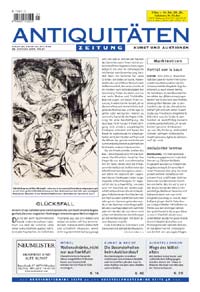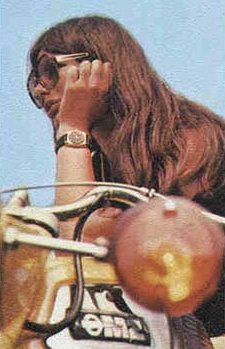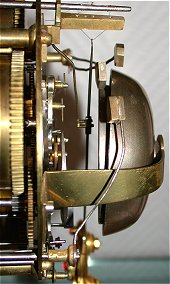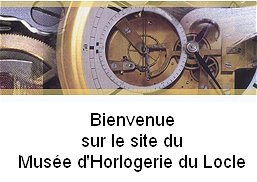
News - Seite 22
Haftung
Kontakt

| . | . | . |
|
News - Seite 22 |
 |
| . |
|
| Autor: | Jürgen Ermert |
| Datum: | 12.11.2004 / 10.02.2005 |
| . | . |
In wenigen Tagen: 6. Markt für elektrische Uhren am
5. März 2005 In
Mannheim-Seckenheim
PS: Jürgen Ermert |
|
|
| Autor: | Jürgen Ermert |
| Datum: | 12.11.2004 |
| . | . |
|
Für den Uhrenfreunde-Nachwuchs:
"Große Uhren
machen Tick-Tack, kleine Uhren machen Ticke-Tacke ....." Auch unsere Kleinsten haben schon viel Spaß an Uhren. Hier als Beispiel ein Singspiel aus einer Spielgruppe mit Babys: Kinder werden mit den Armen am Rumpf vor dem Körper gehalten (Gesicht nach vorne), beim Singen hin und her schaukeln, schwingen etc.
Melodie folgt ... Jürgen Ermert |
||||||||||
|
|
| Autor: | Jürgen Ermert |
| Datum: | 12.11.2004 |
| . | . |
A us aktueller
ANTIQUITÄTEN ZEITUNG:
GLÜCKSFALL. Über Sammeln und
Sammler ... us aktueller
ANTIQUITÄTEN ZEITUNG:
GLÜCKSFALL. Über Sammeln und
Sammler ...Erneut ist mir in der aktuellen Ausgabe von ANTIQUITÄTEN ZEITUNG ein interessanter Artikel aufgefallen, diesmal von Annegret Erhard zum Thema "Sammeln und Sammler". Dieser Artikel ist amüsant und treffend geschrieben. Die ANTIQUITÄTEN ZEITUNG hat der UhrenH@nse freundlicherweise eine Veröffentlichung im Web gestattet. Dafür herzlichen Dank ! Den Artikel findest Du hier. Im übrigen empfehle ich die 14tägig erscheinende ANTIQUITÄTEN ZEITUNG all denen, die einen umfassenden und aktuellen Stand über Ausstellungen und vor allem Auktionen haben möchte. Interessant ist hierbei, dass auch Informationen von nicht so bekannten Auktionshäusern geboten werden, bei denen man öfters ausgefallene Uhren finden kann. Gute Artikel vom Uhrenkenner Jonathan W. Franks runden dies ab. So hat Franks in der aktuellen Ausgabe die Versteigerung einer Uhr auf schiefer Ebene beim Auktionshaus Dr. Crott zum Anlass genommen, ausführlicher diese Art von Uhren zu betrachten. Interessant finde ich auch seinen Bericht von der Versteigerung der Sammlung Seth Atwood (zuletzt im Time Museum), die im Oktober bei Sotheby's New York stattfand. Jürgen Ermert |
|
|
| Autor: | Jürgen Ermert |
| Datum: | 12.11.2004 |
| . | . |
|
Nützlich: Nebenuhrsteuerungen für
elektrische Großuhren Hier eine nützliche Information für Turmuhrenfreunde von Richard Härtel:
|
|
|
| Autor: | Jürgen Ermert |
| Datum: | 16.11.2004 |
| . | . |
|
WELTKUNST-Magazin:
Herrliche Unruhen - Uhren als Sammelobjekte Ich hatte ja schon darauf hingewiesen (siehe News Nr. 143), dass in dem vorzüglichen, 14 mal im Jahr erscheinenden Magazins "Weltkunst - Aktuelle Zeitschrift für Kunst und Antiquitäten", das ebenso wie die ANTIQUITÄTEN ZEITUNG (siehe News Nr. 213) vom Weltkunst-Verlag herausgegeben wird, immer wieder das Thema "Antike Uhren und Zeitmessung" kompetent aufgegriffen wird. Hierzu - leider etwas verspätet - folgende
Information:
Sehr interessant finde ich auch die Statements von Herrn Prof. Helmut Kahlert (Pro) sowie Prof. Eduard Saluz (Contra) bei "Pro + Contra: Müssen historische Uhren laufen ?". Ich hoffe, dass ich vom Weltkunst-Verlag die Genehmigung bekomme, diese immer wieder gerne unter Uhrensammlern erörterte Fragestellung bei UhrenH@nse zu veröffentlichen. Da schon bald das neue Weltkunst-Heft erscheint, solltest Du schnell wegen des November-Magazins nachfragen. Sicher sind aber auch Exemplare direkt beim Weltkunst-Verlag zu beziehen. Jürgen Ermert |
|
|
| Autor: | Jürgen Ermert / Fortunat Mueller-Maerki |
| Datum: | 16.11.2004 |
| . | . |
|
NAWCC-Book
review by Fortunat Mueller-Maerki “Huygens Legacy“ The Golden Age of
the Pendulum Clock" Der vorzügliche Katalog der Ausstellung "Opwindende klokken - De gouden eeuw van het slingeruurwerk" (Huygens Legacy - The golden age of the pendulum clock) - siehe News Nr. 201 - ist jetzt auch von Fortunat Mueller-Maerki für das NAWCC-Bulletin besprochen worden. Fortunat hat mir gestattet, seinen book review hier zu veröffentlichen. Danke dafür ! © NAWCC / Fortunat Mueller-Maerki 2004 Book review by
Fortunat Mueller-Maerki ---- For
NAWCC-Bulletin Huygens’ Legacy – The Golden Age of the Pendulum Clock (An Exhibition coordinated by the Dutch Section of the Antiquarian Horological Society in collaboration with other collectors). Authors: Hans van den Ende, Frits and Maria van Kersen, John C. and Neil R. Taylor. 301 pages, ISBN 0 9548339 0 2; published 2004 by Fromanteel Ldt, Isle of Man (UK), US$100 (Hardback) or US$90 (Paperback) incl. shipping from Europe, order by e-mailing to ahsnl@hccnet.nl. Also available for lending by members from the Library and Research Center at the National Watch and Clock Museum in Columbia, PA. To start with my conclusion: This is the most gorgeous and the most informative book ever published on 17th century pendulum clocks. The Dutch Section of the Antiquarian Horological Society went out of its way to put on what I consider the most important temporary (September through November 2004) show of clocks exhibited in many years. When learning of a few of the pieces featured I decided to make a special trip to the Netherlands and the former royal summer residence, the Paleis Het Loo in Appeldoorn. I was not disappointed. Previously my favorite exhibit had been “Horological Masterworks”, produced in 2003 in the United Kingdom. The 2004 Dutch exhibit not only contained the highlights of the 2003 British exhibit, but built on this core of masterworks, by adding continental pieces of similar importance and rarity to “tell a story”, the story of the first 50 years of the pendulum clock. Ninety clocks were carefully selected for their historical significance to the early history of the pendulum clock. A handful were borrowed from major museums, including the earliest know surviving pendulum clock (Costers’ 1657 clock from the Boerhaave National Science Museum in Leiden) at one end of the time line, and the first year-going, striking, repeating, spring-driven clock (Thompions’ 1695 “Mostyn clock” from the British Museum) at the other end. But the vast majority of the clocks exhibited come from a few private collectors, and have hardly -if ever- been seen by the public, including the earliest known Paris “Religieuse” (Saude, 1659), the earliest known French provincial “Religeuse” (Gilbert, 1660), the earliest hour striking pendulum clock etc, etc. These collectors and the organizers of the exhibit deserve our gratitude for sharing their treasures with horological enthusiasts and the public at large. Of course not
everybody was able to visit the Paleis Het Loo during the 80 day display.
From the beginning the AHS Dutch Section was determined to also provide
a published record of the exhibit. A small brochure in Dutch (Opwinde
Klokken, 20 pages, approx. $7) was ready for the opening of the exhibit,
but the more scholarly full catalog was slightly delayed. Catalogues
from temporary museum exhibits, if done properly, often contain the most
important scholarship on their subject. “Huygens’ Legacy” lives up to
the most stringent standards for content, readability, organization and
production quality. It is so good that some serious horologists have
remarked -only semi-facetiously- “there is no need to go visit the
exhibit in person”. Hans van den Ende and his team of co-authors and photographers had the great advantage that all of them are accomplished and serious horological scholars, so there never was a need to explain things to those who pushed the pen or looked through the lens, they all knew exactly what would be of importance to the reader. The result is a book that closely parallels –and in some ways exceeds- the experience a thoughtful and inquisitive visitor would have going through the exhibit. With only minimal text introducing the chapters (Prologue, Invention & Development, Progression & Innovation, Further Developments and Perfection), the lions share of this 300 page book is devoted to describing in-depth the 90 clocks that tell the early history of the pendulum clock. Each clock gets two, four or six pages of text and images. Each entry starts with the facts on movement, escapement, dial and case (maker, date, dimensions, functions, special features) in table format, followed by a concise description and narrative of why this clock is an important step in the overall story. Each clock than is shown through a minimum of three (or as many as 11) large photographs. Each piece has an overall (cased) view and at least one movement view. In many cases the movement is shown separately from the left, from the right and from the back – simulating the way a student might examine a movement he can take in his hands. Additional pictures provide more than life size blowups of details worth further examination, e.g. of a signature, an escapement, a spandrel, a case detail or some unusual detail. The photography (and the lighting and printing) are of a quality and crispness that exceeds what is usually achievable by physically examining the piece (not to mention that none of us could ever dream of actually handling those priceless masterpieces). Forty-seven short biographies of all the makers represented, Glossary, Bibliography and Index follow the main body of the book. I have little doubt that this book will stand as the definitive work on early pendulum clocks for many years to come. I predict that its print-run will be sold out soon and that this title will within years will be a rare and prized possession for serious students of horological history. Fortunat Mueller-Maerki, Sussex NJ Jürgen Ermert |
|
|
| Autor: | Jürgen Ermert / Hans Eichler |
| Datum: | 17.11.2004 |
| . | . |
|
Rechtzeitig zu Weihnachten: Gustav Schmitt
"Die Comtoise Uhr", 4. Auflage NEU Hier eine erfreuliche Information von Hans Eichler: "Die Comtoise-Uhr" von Gustav
Schm Wegen der hohen Nachfrage und dem unvermindert starken Interesse an Comtoiser Uhren wird noch einmal eine kleine unveränderte Nachauflage dieses gesuchten und beliebten beliebten Buches gedruckt. Die Bücher stehen rechtzeitig vor dem Weihnachtsfest zur Verfügung! Die Auslieferung der ersten druckfrischen Exemplare wird vom 10. - 15. Dezember 2004 stattfinden! Und nun zum Grund dieser
Mail: Beste Grüße aus Stolberg bei
Aachen "Die Comtoise-Uhr" von Gustav Schmitt" ist das deutschsprachige Standardwerk für alle Comtoise-Liebhaber. Ein systematischer Abriss der Geschichte, der Modell-Varianten, der Technik und der Besonderheiten dieses über 230 Jahre lang gebauten Uhren-Typs. Gustav Schmitt ist es gelungen, trotz der großen Vielfalt der Comtoiser Uhren eine grundlegende Systematik zu entwickeln, mit deren Hilfe sowohl der Laie als auch der Fachmann jede Comtoise einordnen kann. Seinem Engagement und seiner Begeisterung für die Comtoiser Uhren ist es zu verdanken, dass dieser schöne Uhren-Typ auch in Deutschland viele Freunde gewonnen hat. Sein Buch ist mittlerweile zum Referenz- und Standardwerk für viele Uhrenfreunde geworden und wird stets eine Bereicherung für jede Uhren-Bibliothek sein. 622 Seiten, 531 Abb. Jürgen Ermert |
|
|
| Autor: | Jürgen Ermert |
| Datum: | 06.12.2004 |
| . | . |
Sonderausstellung im Deutschen Uhrenmuseum:
Uhren aus
Ruhla Vom 11. Dezember 2004 - 6. März 2005 findet im Deutschen Uhrenmuseum in Furtwangen die Sonderausstellung "Uhren aus Ruhla gehen nach wie vor" statt. Wie schreibt das Deutsche Uhrenmuseum dazu:
Nett ist auch "Die Sage vom Ruhlaer Schmied", die das Deutsche Uhrenmuseum anbietet (Link pdf-Dokument 87 KB)) Dass sich neben dem Besuch der Sonderausstellung immer wieder ein Rundgang durch das exzellente Museum lohnt, brauche ich sicher nicht zu erwähnen .... Jürgen Ermert |
|
|
| Autor: | Jürgen Ermert |
| Datum: | 19.12.2004 |
| . | . |
 Definitionen
für Schlagfolgen von Selbstschlagwerken im deutschen Sprachgebrauch Definitionen
für Schlagfolgen von Selbstschlagwerken im deutschen SprachgebrauchDa es immer wieder zu Missverständnissen bei der Angabe der Schlagfolgen von Selbstschlagwerken kommt, habe ich - gemeinsam mit dem Uhrenhistoriker Ian D. Fowler - der Versuch gewagt, eine treffende und eindeutige Namensgebung für die meistverbreiteten Schlagfolgenden zu finden. Diese stützt sich ab auf die Namensnennung in der Literatur sowie die übliche Nutzung. Ich würde mich freuen, wenn speziell die Uhrenmuseen, Uhrensammler-Vereinigungen, Fachzeitschriften und auch die Auktionshäuser bei Ihren Beschreibungen dieses Thema aufgreifen würden, um hier einen „Standard“ zu prägen, und hoffe auf positives Feedback. Die Definitionen für Schlagfolgen findest Du hier. ** Neu 7.1.05 ** Aktualisierte Version Jürgen Ermert |
|
|
| Autor: | Jürgen Ermert |
| Datum: | 19.12.2004 |
| . | . |
 Neue Website
des
Musée d'horlogerie in Le Locle Neue Website
des
Musée d'horlogerie in Le Locle Endlich hat - zumindest habe ich sie erst jetzt entdeckt, ist aber offensichtlich aus 2003 ? - eines meiner Lieblings-Uhrenmuseen - das Musée d'horlogerie in Le Locle (Schweiz) eine neue Website. Zu finden unter >> http://www.mhl-monts.ch. Die Informationen sind zwar nur in französischer Sprache, aber dennoch leicht verständlich / interpretierbar und die Bilder sprechen ja für sich ... Jürgen Ermert |